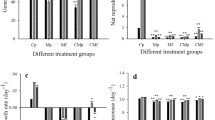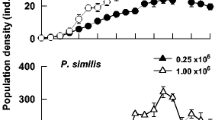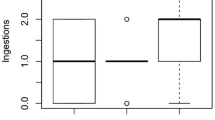Abstract
We investigated the population dynamics of the rotifer Brachionus rotundiformis fed with the alga Isochrysis galbana at two food concentrations (3 × 104 and 40 × 104 cells ml−1) and four salinity levels (5, 10, 20, and 30) in the presence and absence of two copepod species, Pseudodiaptomus annandalei and Apocyclops royi and one cladoceran, Diaphanosoma aspinosum. Both the density and population growth rate of B. rotundiformis increased at higher food concentration and at salinity levels of 10 and 20. Among the microcrustaceans, only P. annandalei had a significant negative effect on the growth rate of the rotifer population because of its efficient predation. In contrast, the presence of both A. royi and D. aspinosum did not affect the growth rates at any of the salinity and food levels. Brachionus rotundiformis had significantly larger size during the log-phase, particularly if P. annandalei was present. Thus, B. rotundiformis grows better at higher food level and medium salinity levels. Unlike the larger calanoid, P. annandalei, B. rotundiformis can definitely coexist with relatively small cyclopoid copepods (A. royi) and cladocerans (D. aspinosum), because of the absence of interference.



Similar content being viewed by others
References
Allan, J. D., 1976. Life history patterns in zooplankton. American Naturalist 110: 165–180.
Baião, C. F., M. J. Caramujo & M. J. Boavida, 1999. Morphological variation of Keratella cochlearis in the presence of cyclopoid copepods in Meimoa Reservoir. Limnetica 16: 33–38.
Bielanska-Grajner, I., 1995. Influence of temperature on morphological variation in populations of Keratella cochlearis (Gosse) in Rybnik Reservoir. Hydrobiologia 313/314: 139–146.
Brandl, Z., 2005. Freshwater copepods and rotifers: predators and their prey. Hydrobiologia 546: 475–489.
Burns, C. W. & J. J. Gilbert, 1986. Direct observations of the mechanisms of interference between Daphnia and Keratella cochlearis. Limnology and Oceanography 31: 859–866.
Chang, K. H. & T. Hanazato, 2005. Impact of selective predation by Mesocyclops pehpeiensis on a zooplankton community: experimental analysis using mesocosms. Ecological Research 20: 726–732.
Chen, Q., J. Sheng, Q. Lin, Y. Gao & J. Lv, 2006. Effect of salinity on reproduction and survival of the copepod Pseudodiaptomus annandalei Sewell, 1919. Aquaculture 258: 575–582.
Cheng, S. H., S. Aoki, M. Maeda & A. Hino, 2004. Competition between the rotifer Brachionus rotundiformes and the ciliate Euplotes vannus fed on two different algae. Aquaculture 241: 331–343.
Diéguez, M. & J. J. Gilbert, 2002. Suppression of the rotifer Polyarthra remata by the omnivorous copepod Tropocyclops extensus: predation or competition. Journal of Plankton Research 24: 359–369.
Diéguez, M., B. Modenutti & C. Queimaliños, 1998. Influence of abiotic and biotic factors on morphological variation of Keratella cochlearis (Gosse) in a small Andean lake. Hydrobiologia 387/388: 289–294.
Dumont, H. J., S. S. S. Sarma & A. Jawahar Ali, 1995. Laboratory studies on the population dynamics of Anuraeopsis fissa (Rotifera) in relation to food density. Freshwater Biology 33: 39–46.
Feike, M. & R. Heerkloss, 2009. Does Eurytemora affinis (Copepoda) control the population growth of Keratella cochlearis (Rotifera) in the brackish water Darß-Zingst Lagoon (southern Baltic Sea)? Journal of Plankton Research 31: 571–576.
Fernández-Araiza, M. A., S. S. S. Sarma & S. Nandini, 2005. Combined effects of food concentration and temperature on competition among four species of Brachionus (Rotifera). Hydrobiologia 546: 519–534.
Fussmann, G., 1996. The importance of crustacean zooplankton in structuring rotifer and phytoplankton communities; an enclosure study. Journal of Plankton Research 18: 1897–1915.
Galindo, M. D., C. Guisande & J. Toja, 1993. Reproductive investment of several rotifer species. Hydrobiologia 255/256: 317–324.
Garcia, C. E., S. Nandini & S. S. S. Sarma, 2009. Seasonal dynamics of zooplankton in Lake Huetzalin, Xochimilco (Mexico City, Mexico). Limnologica 39: 283–291.
Gilbert, J. J., 1987. The Polyarthra escape from response: defense against interference from Daphnia. Hydrobiologia 147: 235–238.
Gilbert, J. J., 1988. Suppression of rotifer populations by Daphnia: a review of the evidence, the mechanisms, and the effects on zooplankton community structure. Limnology and Oceanography 33: 1286–1303.
Gliwicz, Z. M. & J. Pijanowska, 1989. The role of predation in zooplankton succession. In Kerfoot, W. C. & A. Sih (eds), Predation: Direct and Indirect Impacts on Aquatic Communities. University Press of New England, Hanover: 253–296.
Guilard, R. & J. H. Ryther, 1962. Studies of marine planktonic diatoms. I. Cyclotella nana Hustedt and Detonulla confervacea (Cleve) Gran. (‘f’ medium). Canadian Journal of Microbiology 8: 229–239.
Gulati, R. D. & W. R. DeMott, 1997. The role of food quality for zooplankton: remarks on the state-of-the-art, perspectives and priorities. Freshwater Biology 38: 753–768.
Haberman, J. & M. Sudzuki, 1998. Some notes on Brachionus rotundiformis (Tschugunoff) in Lake Palaeostomi. Hydrobiologia 387/388: 333–340.
Hagiwara, A., M. M. Jung, T. Sato & K. Hirayama, 1995. Interspecific relations between marine rotifer Brachionus rotundiformis and zooplankton species contaminating in the rotifer mass-culture tank. Fisheries Science 61: 623–627.
Hagiwara, A., W. G. Gallardo, M. Assavaaree, T. Kotani & A. B. de Araujo, 2001. Live food production in Japan: recent progress and future aspects. Aquaculture 200: 111–127.
Hwang, J.-S., R. Kumar, C.-W. Hsieh, A.-Y. Kuo, S. Souissi, M.-H. Hsu, J.-T. Wu, W.-C. Liu, C.-F. Wang & Q.-C. Chen, 2010. Patterns of zooplankton distribution along the marine, estuarine, and riverine portions of the Danshuei Ecosystem in Northern Taiwan. Zoological Studies 49: 335–352.
Iyer, N. & T. R. Rao, 1993. Effect of the epizoic rotifer Brachionus rubens on the population growth of three cladoceran species. Hydrobiologia 255/256: 325–332.
James, C. M. & P. K. M. Thompson, 1986. Production of copepods in an outdoor culture tank. In Proceeding of the symposium on the coastal aquaculture, Marine Biological Association of India, Cochin, India 4: 1275–1280.
Kâ, S., M. Pagano, N. Bâ, M. Bouvy, C. Leboulanger, R. Arfi, O. T. Thiaw, E. H. M. Ndour, D. Corbin, D. Defaye, C. Cuoc & E. Kouassi, 2006. Zooplankton distribution related to environmental factors and phytoplankton in a shallow tropical lake (Lake Guiers, Senegal, West Africa). International Review of Hydrobiology 91: 389–405.
Kak, A., 1999. Field and laboratory studies on interaction between rotifers and cladocerans. PhD Thesis, University of Delhi.
Kak, A. & T. R. Rao, 1998. Does the evasive behavior of Hexarthra influence its competition with cladocerans? Hydrobiologia 387/388: 409–419.
Krebs, C. J., 1985. Ecology: The Experimental Analysis of Distribution and Abundance, 3rd ed. Harper and Row, New York.
Kumar, R., 2003. Effect of Mesocyclops thermocyclopoides (Copepoda, Cyclopoida) predation on population dynamics of different prey: a laboratory study. Journal of Freshwater Ecology 18: 383–393.
Kumar, R. & T. R. Rao, 1999. Demographic responses of adult Mesocyclops thermocyclopoides (Copepoda, Cyclopoida) to different plant and animal diets. Freshwater Biology 42: 487–501.
Kumar, R. & T. R. Rao, 2001. Effect of the cyclopoid copepod Mesocyclops thermocyclopoides on the interactions between the predatory rotifer Asplanchna intermedia and its prey Brachionus calyciflorus and B. angularis. Hydrobiologia 453/454: 261–268.
Lapesa, S., T. W. Snell, D. M. Fields & M. Serra, 2004. Selective feeding of Arctodiaptomus salinus (Copepoda, Calanoida) on co-occurring sibling rotifer species. Freshwater Biology 49: 1053–1061.
Liao, I. C., H. M. Su & E. Y. Chang, 2001. Techniques in finfish larviculture in Taiwan. Aquaculture 200: 1–31.
Lubzens, E., 1987. Raising rotifers for use in aquaculture. Hydrobiologia 147: 245–255.
Lubzens, E., G. Minkoff & S. Marom, 1985. Salinity dependence of sexual and asexual reproduction in the rotifer Brachionus plicatilis. Marine Biology 85: 123–126.
Mustahal, S. Yamasaki & H. Hirata, 1991. Salinity adaptability of five different strains of the rotifer Brachionus plicatilis. Nippon Suisan Gakkaishi 57: 1997–2000.
Nagata, T. & T. Hanazato, 2006. Different predation impacts of two cyclopoid species on a small-sized zooplankton community: an experimental analysis with mesocosms. Hydrobiologia 556: 233–242.
Nandini, S., S. S. S. Sarma & M. D. Hurtado-Bocanegra, 2002. Effect of four species of cladocerans (Crustacea) on the population growth of Brachionus patulus (Rotifera). Acta Hydrochimica et Hydrobiologica 30: 101–107.
Oltra, R. & R. Todoli, 1997. Effects of temperature, salinity and food level on the life history traits of the marine rotifer Synchaeta cecilia valentina, n. subsp. Journal of Plankton Research 19: 693–702.
Pagano, M., L. Saint-Jean, R. Arfi, M. Bouvy & D. Guiral, 1999. Zooplankton food limitation and grazing impact in a eutrophic brackish-water tropical pond (Côte d’Ivoire, West Africa). Hydrobiologia 390: 83–98.
Park, G. S. & H. G. Marshall, 2000. The trophic contributions of rotifers in tidal freshwater and estuarine habitats. Estuarine Coastal and Shelf Science 51: 729–742.
Ramos-Rodriguez, E. & J. M. Conde-Porcuna, 2004. Impact of copepod predation on the fecundity of Keratella cochlearis (Rotifera). Archiv für Hydrobiologie 161: 541–552.
Rao, T. R. & R. Kumar, 2002. Patterns of prey selectivity in the cyclopoid copepod, Mesocyclops thermocyclopoides. Aquatic Ecology 36: 411–424.
Rothhaupt, K. O., 1988. Mechanistic resource competition theory applied to laboratory experiments with zooplankton. Nature 333: 660–662.
Rothhaupt, K. O., 1990. Population growth rates of two closely related rotifer species: effects of food quantity, particle size, and nutritional quality. Freshwater Biology 23: 561–570.
Rothhaupt, K. O., 1995. Algal nutrient limitation affects rotifer growth rate but not ingestion rate. Limnology and Oceanography 40: 1201–1208.
Ruttner-Kolisko, A., 1977. Suggestions for biomass calculation of plankton rotifers. Archiv für Hydrobiologie 8: 71–76.
Sarma, S. S. S. & T. R. Rao, 1987. Effect of food level on body size and egg size in a growing population of the rotifer Brachionus patulus Müller. Archiv für Hydrobiologie 111: 245–253.
Sarma, S. S. S. & S. Nandini, 2001. Life table demography and population growth of Brachionus variabilis Hempel, 1896 in relation to Chlorella vulgaris densities. Hydrobiologia 446/447: 75–83.
Sarma, S. S. S., B. Elguea-Sánchez & S. Nandini, 2002. Effect of salinity on competition between the rotifers Brachionus rotundiformis Tschugunoff and Hexarthra jenkinae (De Beauchamp) (Rotifera). Hydrobiologia 474: 183–188.
Stoecker, D. K. & D. A. Egloff, 1987. Predation by Acartia tonsa Dana on planktonic ciliates and rotifers. Journal of Experimental Marine Biology and Ecology 110: 53–68.
Suchar, V. A. & P. Chigbu, 2006. The effects of algae species and densities on the population growth of the marine rotifer, Colurella dicentra. Journal of Experimental Marine Biology and Ecology 337: 96–102.
Williamson, C. E., 1987. Predator-prey interactions between omnivorous diaptomid copepods and rotifers: the role of prey morphology and behavior. Limnology and Oceanography 32: 167–177.
Williamson, C. E. & N. M. Butler, 1986. Predation on rotifers by the suspension-feeding calanoid copepod Diaptomus pallidus. Limnology and Oceanography 31: 393–402.
Yin, X. W. & W. Zhao, 2008. Studies on life history characteristics of Brachionus plicatilis O. F. Müller (Rotifera) in relation to temperature, salinity and food algae. Aquatic Ecology 42: 165–176.
Yúfera, M., 2001. Studies on Brachionus (Rotifera): an example of interaction between fundamental and applied research. Hydrobiologia 446/447: 383–392.
Yúfera, M. & E. Pascual, 1989. Biomass and elemental composition (C.H.N.) of the rotifer Brachionus plicatilis cultured as larval food. Hydrobiologia 186/187: 371–374.
Acknowledgments
The authors thank the Council of Agriculture of Taiwan for the project (95AS-6.1.6-AI-A1(1)) of S. H. Cheng and are grateful for the assistance provided by the lab staff of J. S. Hwang. Samba Kâ and Ram Kumar are grateful to the National Science Council of Taiwan for post-doctoral fellowships. We are grateful to the National Science Council of Taiwan for financial support to J. S. Hwang (grant nos. NSC98-2621-B-019-001-MY3 and NSC98-2311-B-019-002-MY3). We thank Ramesh Gulati and another anonymous reviewer for their useful comments.
Author information
Authors and Affiliations
Corresponding author
Additional information
Guest editors: J.-S. Hwang and K. Martens / Zooplankton Behavior and Ecology
Rights and permissions
About this article
Cite this article
Cheng, SH., Kâ, S., Kumar, R. et al. Effects of salinity, food level, and the presence of microcrustacean zooplankters on the population dynamics of rotifer Brachionus rotundiformis . Hydrobiologia 666, 289–299 (2011). https://doi.org/10.1007/s10750-011-0615-6
Published:
Issue Date:
DOI: https://doi.org/10.1007/s10750-011-0615-6




